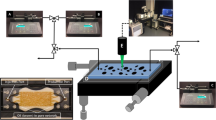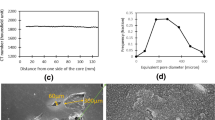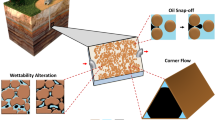Abstract
While there has been a shift towards renewable energy sources, oil remains an important source of not only energy but also raw materials. Oil recovery is currently an inefficient process with as much as 50% of the original oil remaining in a field. Improvement of oil recovery techniques requires a model system that is both chemically and physically representative to achieve accurate results. Current large laboratory scale systems use large cores drilled from target rock and large, high-pressure systems to recreate oil recovery systems. The cores and associated equipment required to accurately model oil recovery are expensive and time consuming to obtain and operate. As a result, there has been a continual quest to develop alternative solutions that are faster, less complicated, and less expensive while still providing accurate representation of reservoirs. An alternative to large-scale models are optically transparent two or three-dimensional microfluidic devices. Several examples of microfluidic devices used to study oil recovery processes have been published. Unfortunately, most microfluidic devices require complicated fabrication techniques, inaccurately replicate the reservoir rock surface chemistry and geometry, and are made from materials not representative of surfaces found in oil reservoirs. Herein, the Flow On Rock Device is described as an easy to fabricate microfluidic device that acts as a bridge between fully synthetic microfluidics and large laboratory models due to incorporation of reservoir rock samples directly into the microfluidic device. Results of flooding studies are presented on shale and sandstone models as an example of the potential for this system in studying oil recovery.






Similar content being viewed by others
References
Abdallah W, Buckley JS, Carnegie A, Edwards J, Herold B, Fordham E, Graue A, Habashy T, Seleznev N, Signer C, Hussain H, Montaron B, Ziauddin M (2007) Fundamentals of wettability. Oilfield Rev 19:44–63
Ali SMF, Thomas S (2000) Enhanced oil recovery—what we have learned. J Can Pet Technol 392:7–11
Alvarado V, Manrique E (2010) Enhanced oil recovery: an update review. Energies 39:1529–1575
Berejnov V, Djilali N, Sinton D (2008) Lab-on-chip methodologies for the study of transport in porous media: energy applications. Lab Chip 85:689–693
Berejnov V, Bazylak A, Sinton D, Djilali N (2010) Fractal flow patterns in hydrophobic microfluidic pore networks: experimental modeling of two-phase flow in porous electrodes. J Electrochem Soc 1575:B760
Boussour S, Cissokho M, Cordier P, Bertin H, Hamon G (2009) Oil recovery by low salinity brine injection: laboratory results on outcrop and reservoir cores. In: SPE Annual technical conference and exhibition. Society of Petroleum Engineers
Buckley JS (1998) Evaluation of reservoir wettability and its effect on oil recovery. N. P. T. Office, Socorro, NM
Buckley JS, Liu Y, Monsterleet S (1998) Mechanisms of wetting alteration by crude oils. SPE J 3:54–61
Camino G, Lomakin SM, Lazzari M (2001) Polydimethylsiloxane thermal degradation Part 1. Kinetic aspects. Polymer 426:2395–2402
Corapcioglu YM, Chowdhury S, Roosevelt SE (1997) Micromodel visualization and quantification of solute transport in porous media. Water Resour Res 3311:2547–2558
Grate JW, Dehoff KJ, Warner MG, Pittman JW, Wietsma TW, Zhang C, Oostrom M (2012) Correlation of oil–water and air–water contact angles of diverse silanized surfaces and relationship to fluid interfacial tensions. Langmuir 2818:7182–7188
Gunda NS, Bera B, Karadimitriou NK, Mitra SK, Hassanizadeh SM (2011) Reservoir-on-a-chip (ROC): a new paradigm in reservoir engineering. Lab Chip 1122:3785–3792
Keller AA, Blunt MJ, Roberts APV (1997) Micromodel observation of the role of oil layers in three-phase flow. Transp Porous Media 263:277–297
Kim M, Sell A, Sinton D (2013) Aquifer-on-a-chip: understanding pore-scale salt precipitation dynamics during CO2 sequestration. Lab Chip 1313:2508–2518
Lager A, Webb KJ, Collins IR (2008) LoSal™ enhanced oil recovery: evidence of enhanced oil recovery at the reservoir scale. In: SPE symposium on improved oil recovery. Society of Petroleum Engineers
Lee JN, Park C, Whitesides GM (2003) Solvent compatibility of poly (dimethylsiloxane)-based microfluidic devices. Anal Chem 7523:6544–6554
Lee H, Lee SG, Doyle PS (2015) Photopatterned oil-reservoir micromodels with tailored wetting properties. Lab Chip 1514:3047–3055
Lenormand R (1990) Liquids in porous media. J Phys Condens Matter 2:SA79
Li W, Vigil RD, Beresnev IA, Iassonov P, Ewing R (2005) Vibration-induced mobilization of trapped oil ganglia in porous media: experimental validation of a capillary-physics mechanism. J Colloid Interface Sci 2891:193–199
McCool CS, Green DW, Willhite GP (2000) Fluid-rock interactions between xanthan-chromium(III) gel systems and dolomite core material. Soc Pet Eng 15:159–167
McGuire PL, Chatham JR, Paskvan FK, Sommer DM, Carini FH (2005) Low salinity oil recovery: an exciting new EOR opportunity for Alaska’s north slope. In: SPE western regional meeting. Society of Petroleum Engineers
Mullins OC, Zuo JY, Wang K, Hammond PS, De Santos R, Dumont H, Mishra VK, Chen L, Pomerantz AE, Dong CL, Elshahawf H, Seifert DJ (2014) The dynamics of reservoir fluids and their substantial systematic variations. Petrophys 552:96–112
Nasralla RA, Alotaibi MB, Nasr-El-Din HA (2011) Efficiency of oil recovery by low salinity water flooding in sandstone reservoirs. In: SPE western North American region meeting. Society of Petroleum Engineers
Ng KM, Davis HT, Scriven LE (1978) Visualization of blob mechanics in flow through porous media. Chem Eng Sci 33:1009–1017
Nobakht M, Moghadam S, Gu Y (2007) Effects of viscous and capillary forces on CO2 enhanced oil recovery under reservoir conditions. Energy Fuels 216:3469–3476
Pope GA (2007) Overview of chemical EOR. Casper EOR workshop. Center for Petroleum and Geosystems Engineering, Austin
Rivet SM, Lake LW (2010) A coreflood investigation of low-salinity enhanced oil recovery. In: SPE annual technical conference and exhibition. Society of Petroleum Engineers
Sayegh SG, Fisher DB (2009) Enhanced oil recovery by CO flooding in homogeneous and heterogeneous 2D micromodels. Petroleum Society of Canada, Canada
Schneider M, Osselin F, Andrews B, Rezgui F, Tabeling P (2011) Wettability determination of core samples through visual rock and fluid imaging during fluid injection. J Pet Sci Eng 782:476–485
Sevin J, Capron B (2013) Seizing the EOR opportunity. Energy Perspect
Sohrabi M, Danesh A, Jamiolahmady M (2008) Visualisation of residual oil recovery by near-miscible gas and SWAG injection using high-pressure micromodels. Transp Porous Media 742:239–257
Tanino Y, Akamairo B, Christensen M, Bowden SA (2015) Impact of displacement rate on waterflood oil recovery under mixed-wet conditions. In: Proceedings of the international symposium of the society of core analysts, society of core analysis
Tarvin JA, Gustavson G, Balkunas S, Sherwood JD (2008) Two-dimensional flow towards a guarded downhole sampling probe: an experimental study. J Pet Sci Eng 612-4:75–87
Terry RE (2001) Enhanced oil recovery. In: Encyclopedia of physical science and technology, vol 18. Academic, New York, pp 503–518
Wang W, Chang S, Gizzatov A (2017) Toward reservoir-on-a-chip: fabricating reservoir micromodels by in situ growing calcium carbonate nanocrystals in microfluidic channels. ACS Appl Mater Interfaces 934:29380–29386
Zekri A, Jerbi KK (2002) Évaluation économique de la récupération assistée du pétrole. Oil Gas Sci Technol 573:259–267
Zhang C, Oostrom M, Wietsma TW, Grate JW, Warner MG (2011) Influence of viscous and capillary forces on immiscible fluid displacement: pore-scale experimental study in a water-wet micromodel demonstrating viscous and capillary fingering. Energy Fuels 258:3493–3505
Acknowledgements
Funding for this project was provided by BP.
Author information
Authors and Affiliations
Corresponding author
Additional information
Publisher’s Note
Springer Nature remains neutral with regard to jurisdictional claims in published maps and institutional affiliations.
Electronic supplementary material
Below is the link to the electronic supplementary material.
Supplementary material 1 (MP4 2280 KB)
Rights and permissions
About this article
Cite this article
Gerold, C.T., Krummel, A.T. & Henry, C.S. Microfluidic devices containing thin rock sections for oil recovery studies. Microfluid Nanofluid 22, 76 (2018). https://doi.org/10.1007/s10404-018-2096-7
Received:
Accepted:
Published:
DOI: https://doi.org/10.1007/s10404-018-2096-7




